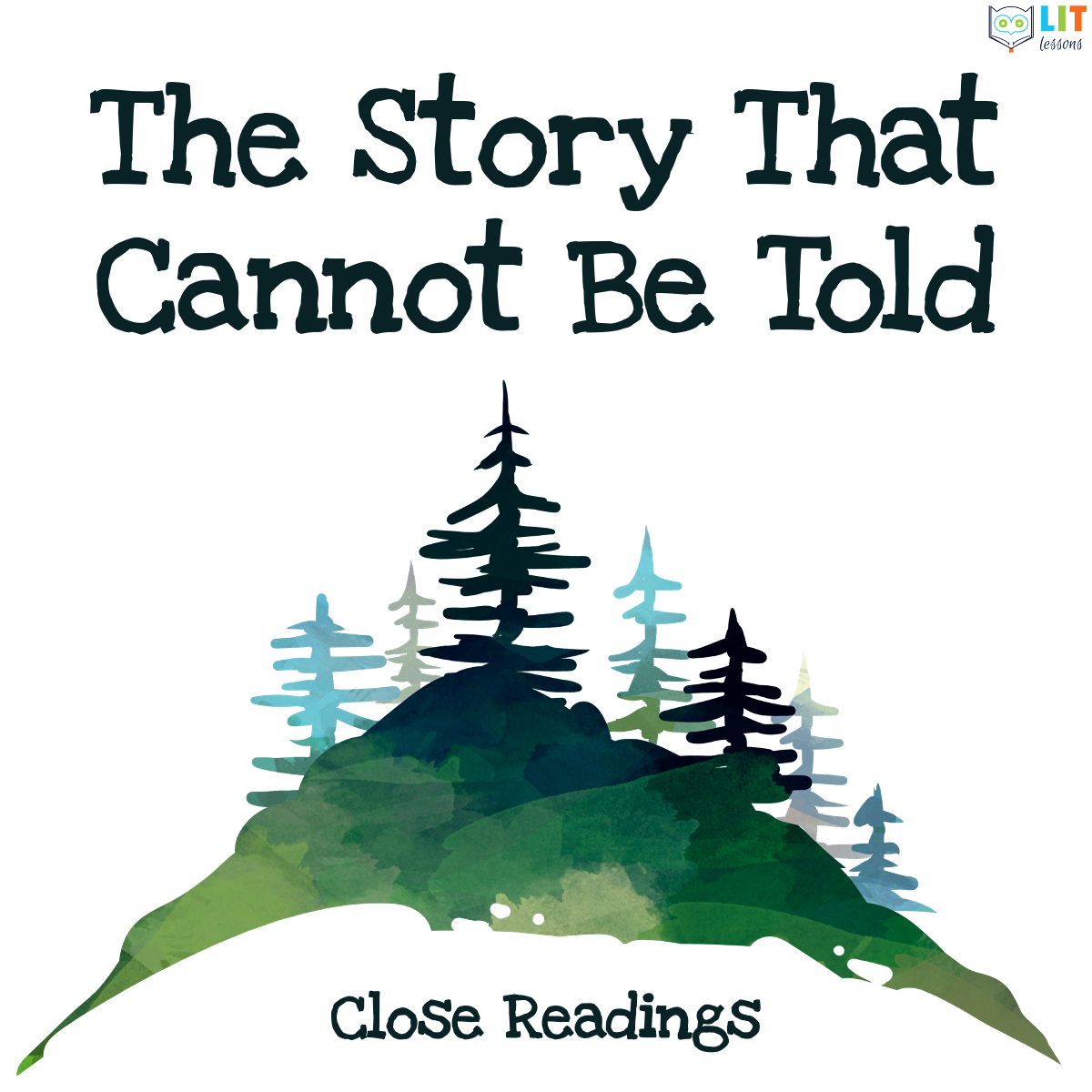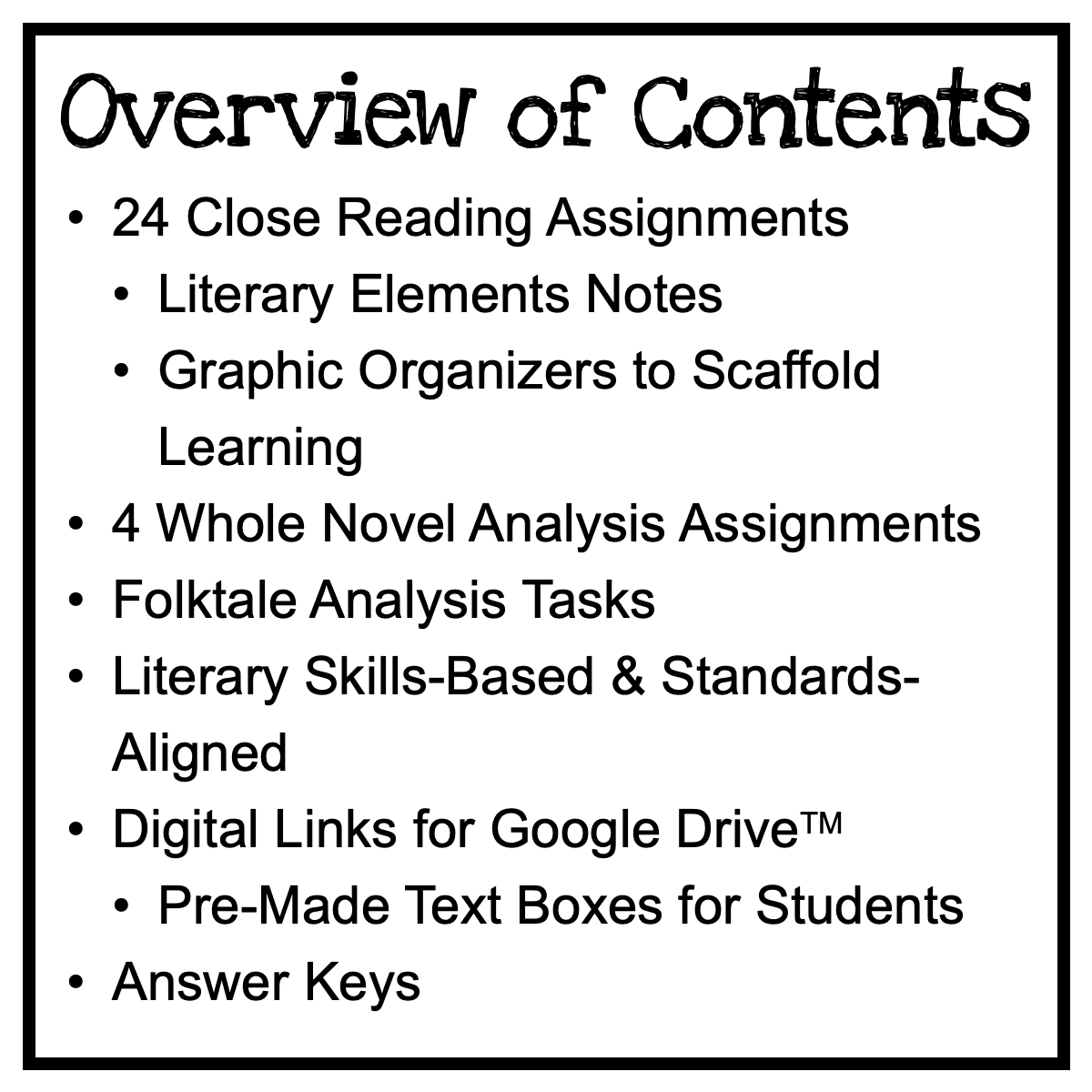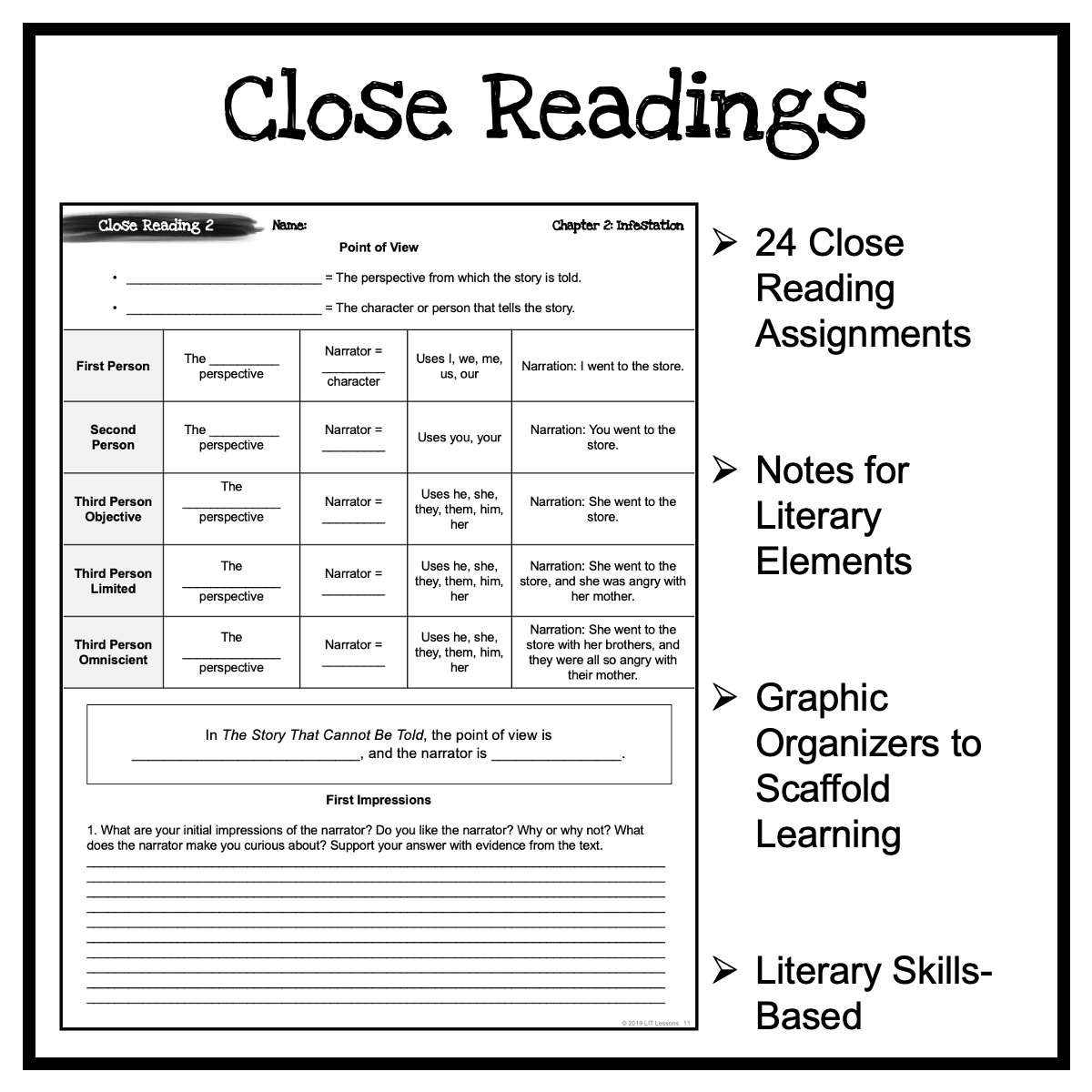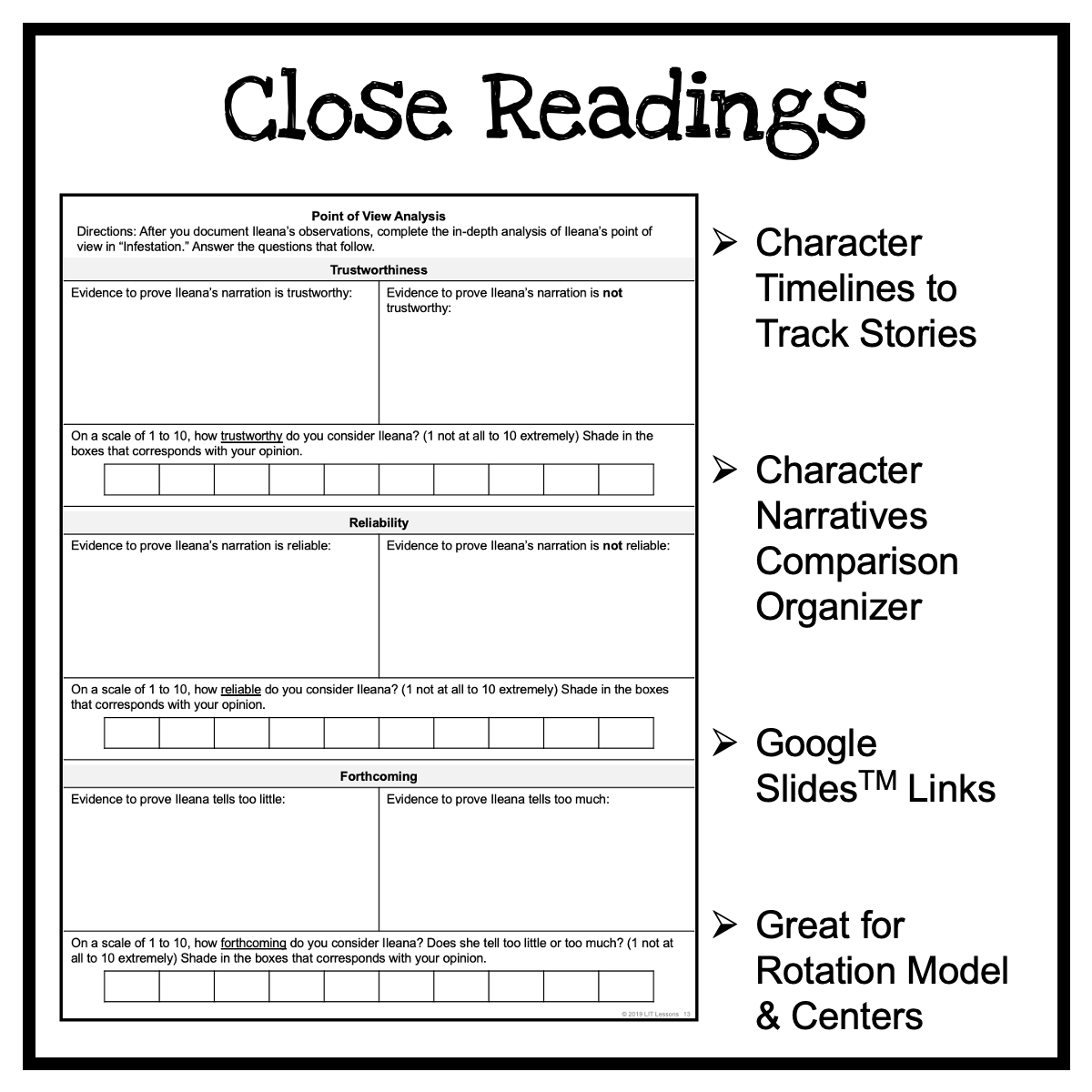The Story That Cannot Be Told Close Readings
You can only add to a wishlist if you have an account, please register now.
Create an Account$8
The Story That Cannot Be Told Close Readings – Snapshot of Included Resources:
- 24 Close Reading Assignments
- Literary Elements Notes
- Graphic Organizers to Scaffold Learning
- 4 Whole Novel Analysis Assignments
- Folktale Analysis Tasks
- Literary Skills-Based & Standards-Aligned
- Digital Links for Google Slides™
- Pre-Made Text Boxes for Students
- Answer Keys
-
Analysis of point of view of the text
-
Author’s use of word choice to develop tone and suspense
-
Analysis of flashbacks
-
Analysis of conflict and plot
-
Identifying and analyzing setting for mood and conflict
-
Character analysis
-
Development of motif and theme across the novel
-
Analysis of figurative language for meaning
-
Identifying and analyzing symbols for deeper meaning
- ZIP file (PDFs and Word Docs for Digital Links)
- Non-Editable
- 10.85 MB
- 144 Pages
- Links for Student Pages in Google Slides™
- This downloadable resource supplies one single-teacher license for use in your classroom.
- Photocopying of this product is allowed only for the classroom use of the purchaser.
- Replication of this product, in whole or in part, for commercial sale or broader distribution is strictly prohibited.
- This product also may NOT be shared electronically, digitally, or otherwise in a manner that violates the Terms of Use detailed by LIT Lessons.
- For explicit information on permissions, please see the Terms of Use document included with this resource. Thank you for your cooperation and understanding.
The Story That Cannot Be Told Close Readings – Snapshot of Included Resources:
- 24 Close Reading Assignments
- Literary Elements Notes
- Graphic Organizers to Scaffold Learning
- 4 Whole Novel Analysis Assignments
- Folktale Analysis Tasks
- Literary Skills-Based & Standards-Aligned
- Digital Links for Google Slides™
- Pre-Made Text Boxes for Students
- Answer Keys
-
Analysis of point of view of the text
-
Author’s use of word choice to develop tone and suspense
-
Analysis of flashbacks
-
Analysis of conflict and plot
-
Identifying and analyzing setting for mood and conflict
-
Character analysis
-
Development of motif and theme across the novel
-
Analysis of figurative language for meaning
-
Identifying and analyzing symbols for deeper meaning
- ZIP file (PDFs and Word Docs for Digital Links)
- Non-Editable
- 10.85 MB
- 144 Pages
- Links for Student Pages in Google Slides™
- This downloadable resource supplies one single-teacher license for use in your classroom.
- Photocopying of this product is allowed only for the classroom use of the purchaser.
- Replication of this product, in whole or in part, for commercial sale or broader distribution is strictly prohibited.
- This product also may NOT be shared electronically, digitally, or otherwise in a manner that violates the Terms of Use detailed by LIT Lessons.
- For explicit information on permissions, please see the Terms of Use document included with this resource. Thank you for your cooperation and understanding.



More The Story That Cannot Be Told Resources...
The Story That Cannot Be Told Novel Study
The Story That Cannot Be Told Novel Study is a comprehensive set of standards-aligned instructional materials for teaching The Story That Cannot Be Told by J. Kasper Kramer. With over 100+ materials, students will deeply engage with the novel and develop their literacy skills. The close reading activities, literary analysis resources, Soviet Bloc nonfiction readings and activities, vocabulary, assessments, and final project options all provide opportunities for your students to practice and apply what will be their growing understanding of the novel. They also provide numerous ways for you to DIFFERENTIATE learning for your students, allowing you to choose the assignments that best support your students’ learning while being conducive to any classroom model.
The Story That Cannot Be Told Chapter Questions
The comprehension guide and literary analysis resources provide a framework for students to deeply engage with every chapter grouping of The Story That Cannot Be Told. The 48 assignments – 24 comprehension and 24 literary analysis – are designed to not only to have students practice essential literary skills but also demonstrate their comprehension of the text. In having students demonstrate their understanding of the novel across both dimensions, the resource allows for differentiation and flexible implementation.
The Story That Cannot Be Told Assessments
The standards-aligned assessments will help you measure your students’ comprehension of The Story That Cannot Be Told and their ability to apply the literary skills taught throughout the unit. The materials include 24 reading checks, 3 novel quizzes, 3 final tests, and essay choice board.
The Story That Cannot Be Told History of the Soviet Bloc Nonfiction Readings & Activities
The 14 nonfiction close readings will build your students’ knowledge about the post-WWII period in history. With a particular focus on the Soviet Union and the Soviet Bloc, the readings illuminate the forces that contributed to deep tensions throughout the Cold War. Since The Story That Cannot Be Told is set in Romania, they focus on the Soviet Union and the Soviet Bloc in order to enhance your students’ understanding of the goals, principles, and tactics that shaped the story’s setting. Therefore, students will be able to synthesize across the nonfiction readings and the novel, building their critical thinking skills in the process. Students will learn about communism’s rise as a governing philosophy, the ways authoritarianism takes hold, and how ordinary people come to experience its effects. As they do, students will also practice key literacy skills aligned to the Common Core Standards, such as using textual evidence, identifying the author’s purpose, and making inferences, to name a few. By the time students finish reading, writing, and analyzing these materials, they will have grown in their ability to think critically, consider new perspectives, and carry with them a deeper understanding of history in the second half of the 20th century.
The Story That Cannot Be Told Vocabulary
The vocabulary resources will engage students in varied activities to expand their vocabulary. The resources include materials to help teach challenging vocabulary words in The Story That Cannot Be Told that will then build your students’ vocabulary. With 6 vocabulary lists of 10 words each and a crossword puzzle, practice assignment, and quiz for each set, the materials provide opportunities for differentiation to suit the needs of the classroom.

The Story That Cannot Be Told Novel Study
The Story That Cannot Be Told Novel Study is a comprehensive set of standards-aligned instructional materials for teaching The Story That Cannot Be Told by J. Kasper Kramer. With over 100+ materials, students will deeply engage with the novel and develop their literacy skills. The close reading activities, literary analysis resources, Soviet Bloc nonfiction readings and activities, vocabulary, assessments, and final project options all provide opportunities for your students to practice and apply what will be their growing understanding of the novel. They also provide numerous ways for you to DIFFERENTIATE learning for your students, allowing you to choose the assignments that best support your students’ learning while being conducive to any classroom model.

The Story That Cannot Be Told Chapter Questions
The comprehension guide and literary analysis resources provide a framework for students to deeply engage with every chapter grouping of The Story That Cannot Be Told. The 48 assignments – 24 comprehension and 24 literary analysis – are designed to not only to have students practice essential literary skills but also demonstrate their comprehension of the text. In having students demonstrate their understanding of the novel across both dimensions, the resource allows for differentiation and flexible implementation.
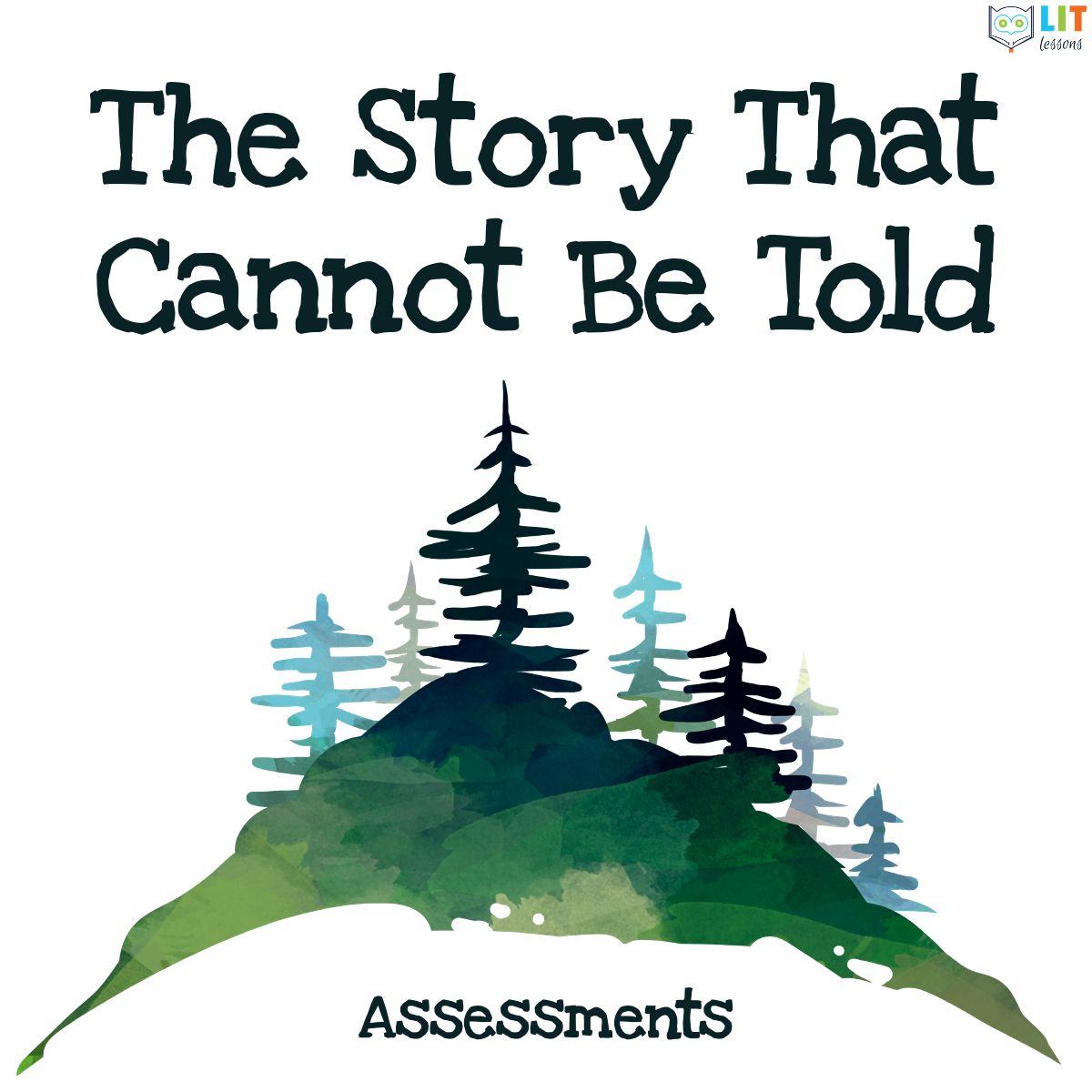
The Story That Cannot Be Told Assessments
The standards-aligned assessments will help you measure your students’ comprehension of The Story That Cannot Be Told and their ability to apply the literary skills taught throughout the unit. The materials include 24 reading checks, 3 novel quizzes, 3 final tests, and essay choice board.
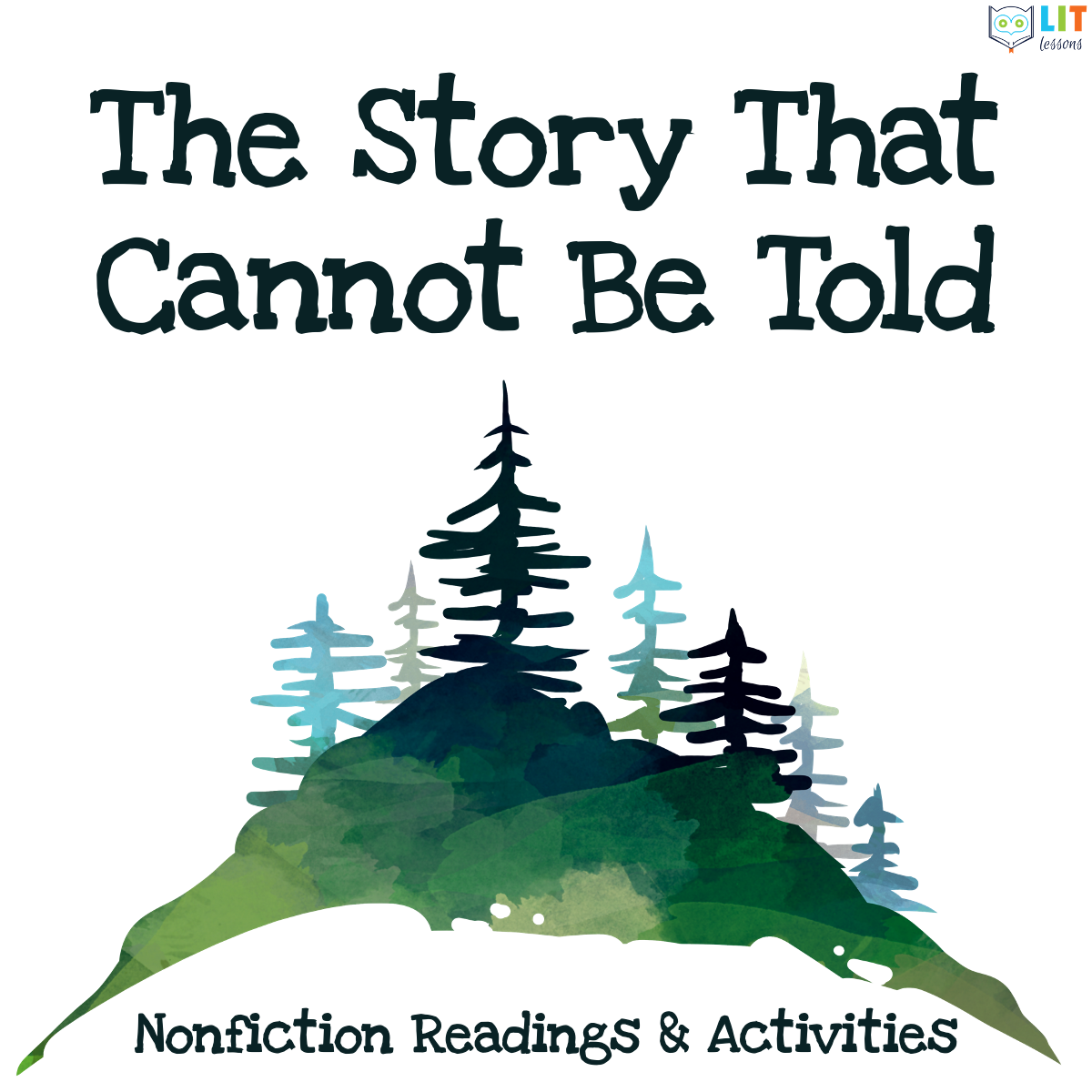
The Story That Cannot Be Told History of the Soviet Bloc Nonfiction Readings & Activities
The 14 nonfiction close readings will build your students’ knowledge about the post-WWII period in history. With a particular focus on the Soviet Union and the Soviet Bloc, the readings illuminate the forces that contributed to deep tensions throughout the Cold War. Since The Story That Cannot Be Told is set in Romania, they focus on the Soviet Union and the Soviet Bloc in order to enhance your students’ understanding of the goals, principles, and tactics that shaped the story’s setting. Therefore, students will be able to synthesize across the nonfiction readings and the novel, building their critical thinking skills in the process. Students will learn about communism’s rise as a governing philosophy, the ways authoritarianism takes hold, and how ordinary people come to experience its effects. As they do, students will also practice key literacy skills aligned to the Common Core Standards, such as using textual evidence, identifying the author’s purpose, and making inferences, to name a few. By the time students finish reading, writing, and analyzing these materials, they will have grown in their ability to think critically, consider new perspectives, and carry with them a deeper understanding of history in the second half of the 20th century.
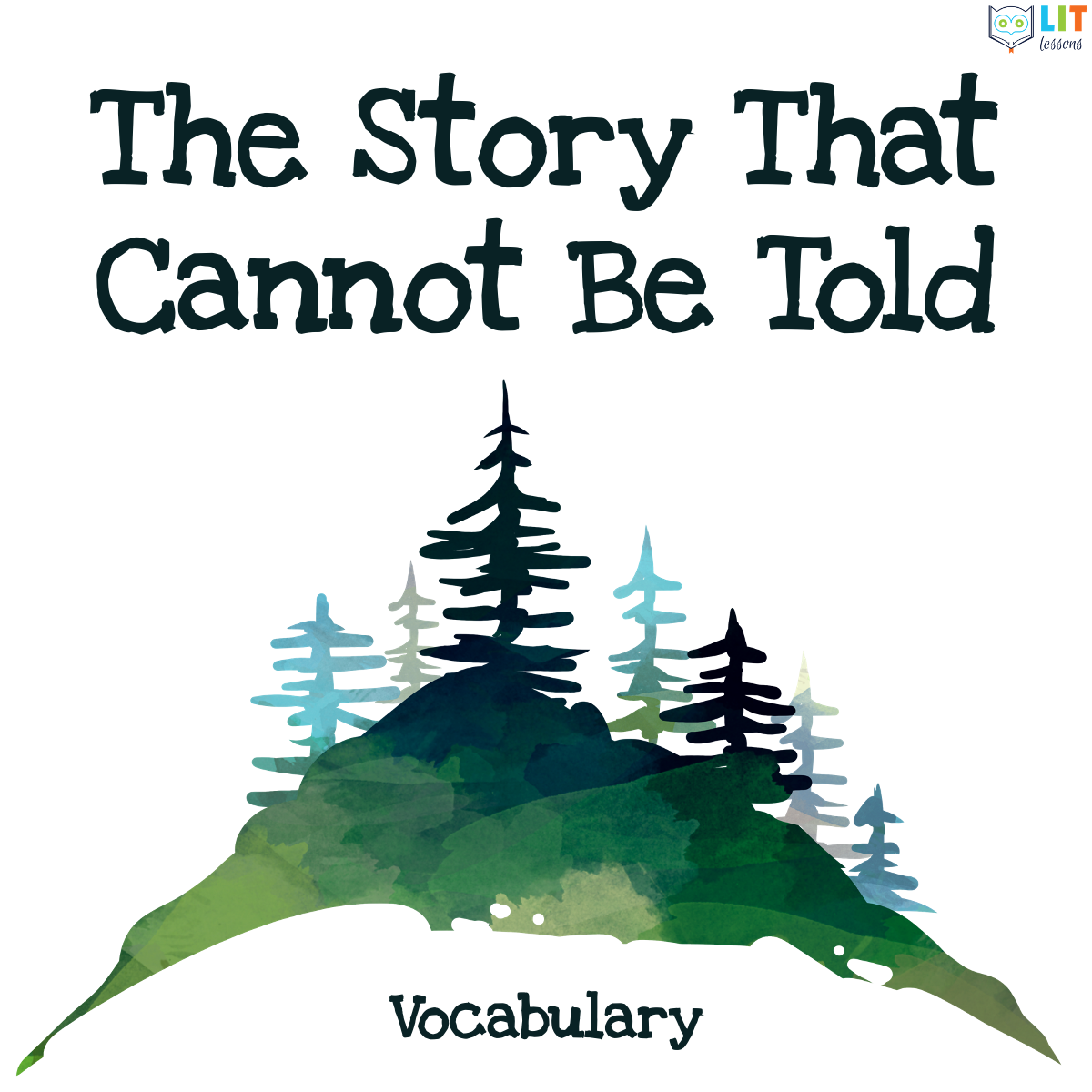
The Story That Cannot Be Told Vocabulary
The vocabulary resources will engage students in varied activities to expand their vocabulary. The resources include materials to help teach challenging vocabulary words in The Story That Cannot Be Told that will then build your students’ vocabulary. With 6 vocabulary lists of 10 words each and a crossword puzzle, practice assignment, and quiz for each set, the materials provide opportunities for differentiation to suit the needs of the classroom.

